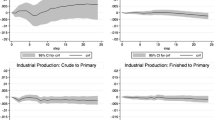Abstract
The Austrian business cycle theory suggests that a monetary shock disturbs relative prices, such as the term structure of interest rates, systematically altering profit rates across economic sectors. Resource use responds to those changes, generating a cyclical pattern of real income. The divergence of the interest rate structure, from the previous and unchanged time preferences, means that the expansion is unsustainable and must end in recession. Quarterly data for eight U.S. business cycles, 1950:1 through 1991:1 are standardized by time period and used to explore business cycle facts and relations between money, interest rates, capacity utilization and income. Results are consistent with the hypotheses of the Austrian theory of a business cycle caused by a monetary shock and propagated by relative price changes.
Similar content being viewed by others
References
Bernanke, B. S. (1990) “On the Predictive Power of Interest Rates and Interest Rate Spreads.” New England Economic Review, 51-68.
Burns, A. F., and Mitchell, W. C. (1946) Measuring Business Cycles. New York: National Bureau of Economic Research.
Council of Economic Advisors (various issues). Economic Report of the President. Washington, D.C.: U.S. Government Printing Office.
Federal Reserve Economic Data (FRED). St. Louis: Federal Reserve Bank of St. Louis.
Federal Reserve Bulletin (various issues).Washington, D. C.: Board of Governors of the Federal Reserve System.
Garrison, R. W. (1986) “Hayekian Trade Cycle Theory: A Reappraisal.” Cato Journal, 6(2): 437-459.
Garrison, R. W. (1991) “New Classical and Old Austrian Economics: Equilibrium Business Cycle Theory in Perspective.” The Review of Austrian Economics, 5(1): 91-103.
Hayek, F. A. [1967 (1935)] Prices and Production, 2nd edn. New York: Augustus M. Kelley.
Hughes, A. M. (1997) “The Recession of 1990: An Austrian Explanation.” Review of Austrian Economics, 10(1): 107-123.
Kydland, F. E., and Prescott, E. C. (1990) “Business Cycles: Real Facts and a Monetary Myth.” Federal Reserve Bank of Minneapolis. Quarterly Review, 14(2): 3-18.
le Roux, P., and Levin, M. (1998) “The Capital Structure and the Business Cycle: Some Tests of the Validity of the Austrian Business Cycle in South Africa.” Journal for Studies in Economics and Econometrics, 22(3): 91-109.
Mises, L. von. [1966 (1949)] Human Action, 3rd revised edn. Chicago: Henry Regnery Company.
Mises, L. von. [1971 (1912)] The Theory of Money and Credit. Irvington-on-Hudson, New York: The Foundation for Economic Education Inc.
Mishkin, F. S. (1981) “The Real Interest Rate: An Empirical Investigation.” In: Brunner, K., and Meltzer, A. (eds.) The Costs and Consequences of Inflation. Carnegie-Rochester Conference on Public Policy: Vol. 15, pp. 151-200. Amsterdam: North-Holland.
Robbins, L. (1934) The Great Depression. London: MacMillan.
Romer, D. (1996) Advanced Macroeconomics. New York: McGraw-Hill.
Rothbard, M. N. (1970) Man, Economy and State. Los Angeles: Nash Publishing Co.
Survey of Current Business (various issues). Washington, D.C.: U.S. Department of Commerce, Bureau of Economic Analysis.
Trautwein, H. M. (1996) “Money, Equilibrium, and the Business Cycle: Hayek'sWicksellian Dichotomy.” History of Political Economy, 28(1): 27-55.
Tullock, G. (1988) “Why the Austrians Are Wrong about Depressions.” Review of Austrian Economics, 2(1): 73-78.
Wainhouse, C. (1984) “Empirical Evidence for Hayek's Theory of Economic Fluctuations.” In: Siegel, B. (ed.) Money in Crisis, pp. 37-71. San Francisco: Pacific Institute for Public Policy Research.
White, L. H. (1984) The Methodology of the Austrian School Economists. Auburn, AL: Ludwig von Mises Institute.
Witte, J. G. (1963) “The Microfoundations of the Social Investment Function.” Journal of Political Economy, LXXI(5): 441-456.
Zarnowitz, V. (1992) Business Cycles: Theory, History, Indicators andForecasting. Chicago: University of Chicago Press.
Zarnowitz, V. (1999) “Theory and History Behind Business Cycles: Are the 1990s the Onset of the Golden Age?” Journal of Economic Perspectives, 13(2): 69-90.
Rights and permissions
About this article
Cite this article
Keeler, J.P. Empirical Evidence on the Austrian Business Cycle Theory. The Review of Austrian Economics 14, 331–351 (2001). https://doi.org/10.1023/A:1011937230775
Issue Date:
DOI: https://doi.org/10.1023/A:1011937230775




